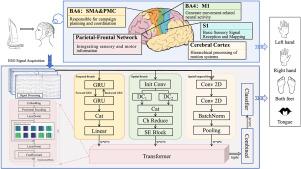BioMIFormer:生物启发的运动图像EEG解释的时空转换器
IF 4.9
2区 医学
Q1 ENGINEERING, BIOMEDICAL
引用次数: 0
摘要
脑电图(EEG)提供了对大脑活动的高时间分辨率,但许多现有的解码模型忽略了其神经生理基础,限制了有效捕获时间和空间动态的能力。为了解决这个问题,我们提出了BioMIFormer,这是一种受生物学启发的时空转换器,它将神经科学的见解整合到运动图像(MI)相关大脑区域的功能结构中。BioMIFormer通过三个平行分支模拟运动皮层的功能划分,用于时间、空间和时空特征编码。它结合了受生物学启发的时间建模机制、多尺度空间提取策略和基于transformer的注意力融合模块,以捕获脑电图信号中的远程依赖关系和跨模态关系。与传统的特征融合方法不同,BioMIFormer将其模块化设计与大脑的功能架构相结合,提高了可解释性和解码精度。在两个公开的MI-EEG数据集上的实验结果表明,BioMIFormer达到了最先进的性能,验证了生物启发建模在EEG分析中的有效性。本文章由计算机程序翻译,如有差异,请以英文原文为准。

BioMIFormer: Biologically inspired spatiotemporal transformer for motor imagery EEG interpretation
Electroencephalography (EEG) provides a high temporal resolution into brain activity, yet many existing decoding models overlook its neurophysiological basis, limiting the ability to capture both temporal and spatial dynamics effectively. To address this, we propose BioMIFormer, a Biologically Inspired Spatiotemporal Transformer that integrates neuroscientific insights into the functional architecture of motor imagery (MI)-related brain regions. BioMIFormer simulates functional divisions of the motor cortex through three parallel branches for temporal, spatial, and spatiotemporal feature encoding. It incorporates a biologically inspired temporal modeling mechanism, a multi-scale spatial extraction strategy, and a Transformer-based attention fusion module to capture long-range dependencies and cross-modal relationships in EEG signals. Different from the traditional feature fusion methods, BioMIFormer aligns its modular design with the brain’s functional architecture, enhancing both interpretability and decoding accuracy. Experimental results on two public MI-EEG datasets demonstrate that BioMIFormer achieves state-of-the-art performance, validating the effectiveness of biologically inspired modeling in EEG analysis.
求助全文
通过发布文献求助,成功后即可免费获取论文全文。
去求助
来源期刊

Biomedical Signal Processing and Control
工程技术-工程:生物医学
CiteScore
9.80
自引率
13.70%
发文量
822
审稿时长
4 months
期刊介绍:
Biomedical Signal Processing and Control aims to provide a cross-disciplinary international forum for the interchange of information on research in the measurement and analysis of signals and images in clinical medicine and the biological sciences. Emphasis is placed on contributions dealing with the practical, applications-led research on the use of methods and devices in clinical diagnosis, patient monitoring and management.
Biomedical Signal Processing and Control reflects the main areas in which these methods are being used and developed at the interface of both engineering and clinical science. The scope of the journal is defined to include relevant review papers, technical notes, short communications and letters. Tutorial papers and special issues will also be published.
 求助内容:
求助内容: 应助结果提醒方式:
应助结果提醒方式:


